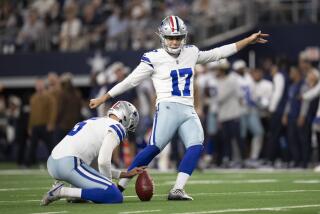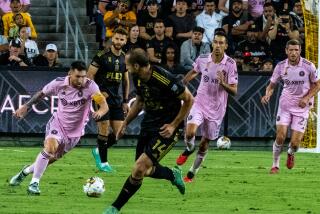Ripped, buff, tough -- it’s a goal
As the World Cup games roll on in Germany, many soccer fans have noticed more than the deft ball control, precise play-making and flurries of yellow cards: With lust or envy, they’ve registered the physiques of the men on the pitch.
Pound for pound, professional soccer players are among the fittest team athletes in the world. In the course of a 90-minute game, they will cover as much as six miles, depending on the position they play. They spend 70% to 80% of the time running, often at a full sprint, while jumping, spinning, pivoting and kicking with pinpoint accuracy.
But there’s another, aesthetic component. Elite soccer players have tough, toned bodies that are buff yet less extreme than, say, football players and many other athletes.
“A distance runner has lean legs but doesn’t have a lot of upper body strength, while a sprinter has huge legs,” says Michael Bergeron, an applied physiologist and at the Medical College of Georgia in Augusta.
“Now you take a blend of both, which the soccer player has,” he says, throw in some ripped abdominals “and you have a lower body that looks pretty good.”
How to get a body that looks like that?
The best way, of course, is to actually play soccer. That’s how the pros do it. At the L.A. Galaxy training camp in Carson, the team works out about two hours a day, says head athletic trainer Ivan Pierra. There’s no vigilant attention to diet nor complex gym prescriptions: Although the practice regimen varies day to day, depending on what skills the team needs to work on, mostly it tracks closely with the moves required in an actual game.
“The way you get to be a good soccer player is by playing a lot of soccer,” says Dr. Margot Putukian, director of athletic medicine for Princeton University.
Play the game often, and the body -- to some extent -- will follow.
Soccer has been elevated to a near-religion in parts of Europe and Latin America, but it is also widely popular in the U.S. Last year, an estimated 17 million Americans played soccer at least once, according to the Sporting Goods Manufacturers Assn., making soccer the third-most popular team sport in America, behind basketball and volleyball.
There are plenty of places in Los Angeles where men and women can play, from novice to semi-professional.
For lists of local clubs and leagues, go to www.at-la.com/sports/la-soccer.htm or inlandsoccer.net/southern_california_soccer.htm.
There are good reasons why soccer players have the physiques that they do.
In broad terms, the pace of a soccer game is roughly equivalent to interval training -- periods of high-intensity exercise followed by periods of low-intensity exercise, says sports physiologist Mike Bracko, a spokesman for the American College of Sports Medicine in Indianapolis.
The elite player must have excellent core strength because of all the jumping and heading in the game. “When you strike a ball with your head, most of the power comes from the core,” says Putukian, a former player and devout fan, talking by phone while following World Cup action on TV. This, she says, “is why they have the abdominal musculature that you see.”
Because the game requires nimble footwork and explosive speed mixed with extreme endurance, the soccer player must be lean enough to run fast, and sturdy enough to last the entire game. That’s pretty much nonnegotiable, with the occasional exception of the skinny player who happens to be so strong he’s able to go the distance.
That’s why, at this level, you don’t see overweight soccer players -- unlike, say, baseball or football players.
“You don’t see any William ‘The Refrigerator’ Perrys in soccer,” says Bruce Morgan, head athletic trainer for Houston Dynamo, formerly the San Jose Earthquakes.
Which brings us to Ronaldo. When Brazil’s 6-foot star striker (who last week broke the all-time record for cumulative World Cup goals) topped 189 pounds while recovering from an injury, newspapers from Beijing to Berlin to Rio to Bombay weighed in. Never mind that he was a sylph by American football standards, Ronaldo even heard about it from Brazil’s president, who somewhat indelicately asked the national team’s coach: “Is he fat or not?”
The remark elevated Ronaldo’s extra kilos to a national emergency.
The next day the president apologized.
*
The body without the game
Organized soccer isn’t for everyone, of course, which might lead one to ask how to get that David Beckham (or Brandi Chastain) body without regularly running around a field kicking a ball for 90 minutes.
For a quickie soccer body, think legs, abs, back and arms.
* For glutes, quads and calves -- try squats with barbells on the shoulder. Set the weight so you can do 15 to 20 repetitions. You may wish to supplement that with lunges while holding dumbbells.
* For abs -- try the “front plank.” This exercise is performed lying on the stomach, with arms bent at the elbow. Raise up onto the elbows, keeping elbows shoulder width, and straighten the body, toes pointed downward, to look like what the exercise is called, a plank.
* For the back -- do the “bird dog.” Start on all fours, extend the right hand straight in front, extend the left leg straight behind, then bring both down to the original position. Repeat 15 to 20 times, then switch to the other side.
* For arms -- try machine chest presses or bench presses with dumbbells. The key is to get toned without bulking up, a hallmark of elite soccer players.
But sadly, capturing the soccer player’s broad appeal may take more than a proportioned body and toned physique. Some say part of it boils down to something simpler: skimpy uniforms and good hair.
“It doesn’t surprise me that women might think that soccer players are hunky,” Bracko says. “Soccer players wear shorts and short-sleeved shirts, and you can see their legs and arms and face, whereas hockey players have these silly short pants on, silly shin pads on, then a helmet, and some wear a visor, and then ... they grow playoff beards.
“Soccer players also are a little more flamboyant,” which adds to their appeal, Bracko says. “They either have a shaved head, or they do a David Beckham kind of hairdo. Maybe it’s the European influence. They just seem sexier.”





